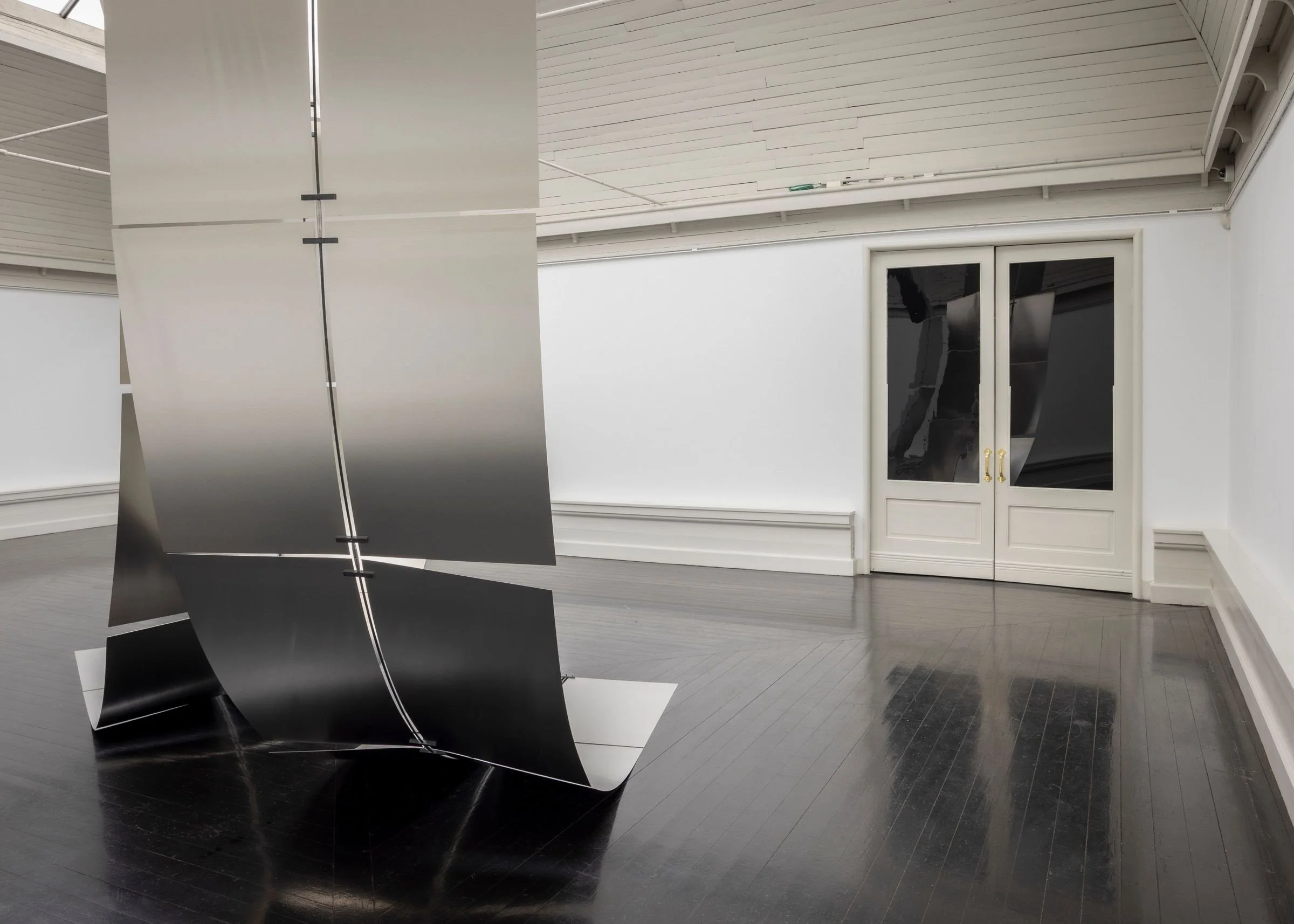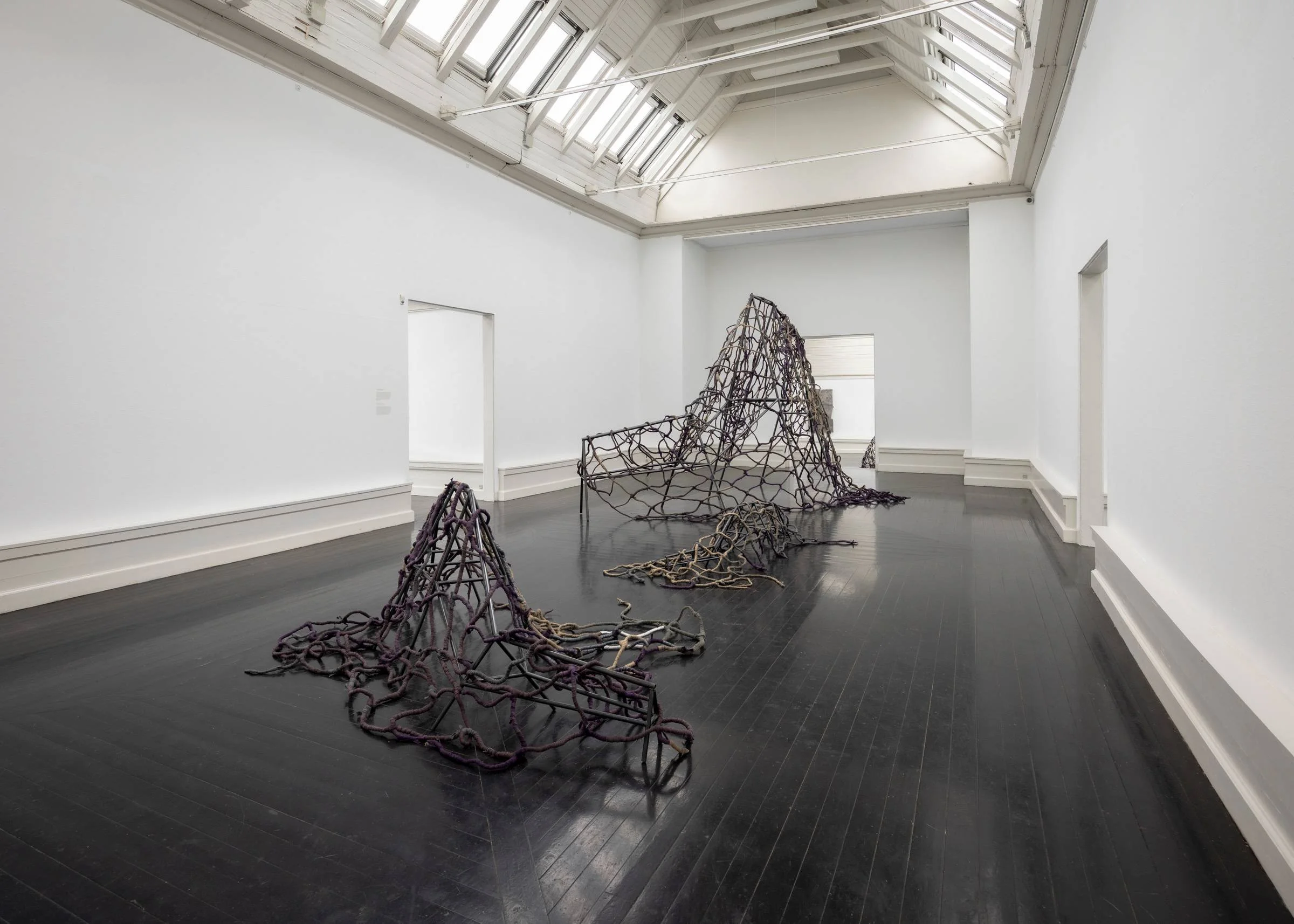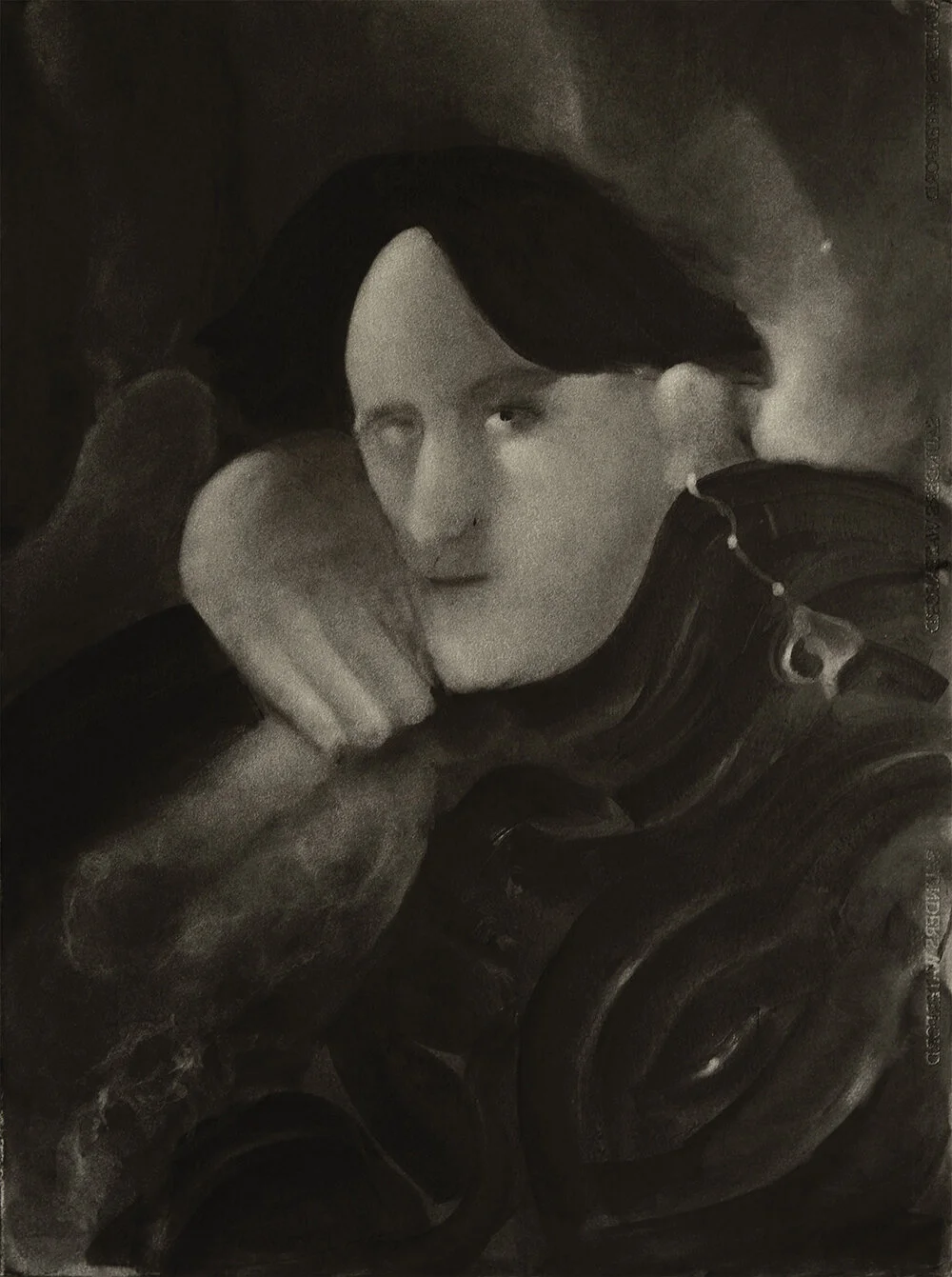Sandra Mujinga
In his take on the Actor-Network Theory, Bruno Latour presents three ways of communication; inter-human, human-non-human, and inter-non-human. Somehow, all three seems to apply faced with the work of Sandra Mujinga. Her monumental sculptures appear at the intersections of objects and subjects, animal and human, organic and in-organic.
Beyond their scale, Mujinga’s sculptures are characterized by their multiple layers, both in terms of materials and content. Drawing on references from science fiction, post-humanity, archology, and ecology, they reflect critically on the past, but even more they seem to look to the future, or multiple futures. In an ever more polemic world, Mujinga offers a potential third way, where human and non-human, technology and nature, may come together in a form of constructive pessimism.
Her current exhibition at Den Frie in Copenhagen, encourages the audience to make their own route through the historical building, transcending linear narratives and experiences of time and space.
Moving through your current exhibition at Den Frie, one of the things that stroke me was that there are multiple layers unfolding from one room to the next. There’s no set route, and thus the narrative is shaped by my selected route. This impression is further echoed by the title of the exhibition Sløyfe [which is Danish/Norwegian for loop] – there’s no set beginning nor end, which works really well with the multiple entries and ways one can move to the space of Den frie. How did the architecture of Den Frie play into your current exhibition?
I was really drawn to the octagonal rooms, despite their geometry, they felt like they were mirroring each other in a way that was quite unexpected. I was also intrigued by the presence of hidden rooms and concealed doors. There were architectural elements that looked like they had always been part of the building, yet they could just as easily have been newly constructed. That ghostly ambiguity is something I find interesting.
It got me thinking about the uncanniness of architecture, how we relate to new structures, new walls, or corners, and how they physically influence our movement and our bodies. There’s a tension between familiarity and newness. Even before something is built, you might imagine a wall or structure already being there, as if it were latent or waiting to appear.
I was especially struck by how the building itself felt alive. It resembled a kind of labyrinth, a continuous unfolding space. That aliveness reminded me of how I often imagine Oankalis spaceship in Lilith’s Brood, that book recurs often in my work. The spaceship is sentient, responsive, and has its own agency. In a similar way, I wanted to think of the building as a living body, something that reacts when you touch it or leave a trace on it.
The first work that met me as I entered was the photographic Shared Breath series. At first glance they appear as they are portraying different people, but in reality, it’s the same face altered many times, through which you are commenting on the increasing surveillance in our societies, and in turn how this affects us. Here, you are presenting both the possible tools for protection and as threats to the liberty of our minds and bodies. In what way do you think our notion of self is being affected by the rapid changes caused by the current technological boom?
Shared Breath is a continuation of the process I began with the LACK series, two of which are currently up in the contemporary collection show at Stedelijk Museum. I’ve been exploring utopian ideas of face-sharing, wondering what it might look like to share a face in real time as a form of protection. That led me to think about face-sharing as a kind of collage: what happens when you borrow someone’s nose, someone else’s lips, or eyes? The result is a face that doesn’t quite align, a face that feels unfamiliar or even slightly off, but somehow still insistent.
These portraits came to life through trust, people allowing me to photograph them, allowing me to borrow parts of their faces and recombine them into something new. That process ended up later inspiring Time as a Shield, where I began thinking about voices, and specifically choirs, how it’s a similar process, how an individual /as a voice, can exist within a collective. What does it mean to scream, to perform, but under the protection of something shared?
The portraits are not about perfection, but concealment. I find distortions compelling when something in a deepfake doesn’t quite land, when the image falters or flickers. There’s something very human in that imperfection. Shared Breath embraces those glitches, those in-between states, as part of its language.
Your sculptural works are characterized with a massiveness, in the sense that they are often tall and/or taking up a lot of space. How does scale play into your practice?
Scale, for me, also becomes a tool for evasion, for camouflage. I’m often inspired by the idea of bodies becoming landscape or blending into environments to avoid being seen. There’s a kind of paradox in how scale operates: something can be massive and still be invisible. I think of elephants, a lot, large mammals that deeply inspire me, who are both monumental and yet often erased through violence and neglect. Whales function similarly in my imagination, as do gorillas, who I’ve worked with in earlier portrait pieces. Their vastness makes them visible targets, but also, in a way, symbolically invisible, like their size marks them for violence and disappearance.
So, scale becomes this feedback loop, this ping-pong effect: it allows us to reflect on our own bodies in relation to something much larger, or much smaller. Sometimes, my sculptures ask the viewer to recalibrate how they physically relate to a form, and that shift can open other ways of thinking about care, attention, or even fear.
Nature plays a huge role in this, too. I’ve been really influenced by specific natural sites, like Gullfoss waterfall in Iceland. Like in one of my early video Face Time/Facetime Real Time/Realtime work from 2013, I filmed the waterfall to reflect on how we’re part of vast, interconnected systems, systems that don’t need to be “larger” in the traditional sense, but that are layered and multi-scalar. We’re also constantly hosting other forms of microorganisms, bacteria, and those scales matter too.
I think scale affects how we place empathy, how we perceive safety, and how we project fear. Whether something feels threatening or tender often comes down to its scale in relation to us. I’m interested in holding that tension.
I fell absolutely in love with your installation Time as a Shield. Visually, the sculptures are moving somewhere between human and non-human bodies. This blurring of dichotomies seems reoccurring in your work. How do you see our relationship to the other (or non-human)?
I think it’s important to reflect on the category of the human, who gets to be seen as fully human, and how dehumanization continues today, often in both overt and subtle ways. This question threads through much of my work. For instance, Time as a Shield was deeply influenced by my reflections on ghost forests, and the concept of hauntology, thinking about what remains, what haunts, and what has been erased.
We live in a time marked by extinction, yet also by the presence of traces. One example that stayed with me is the recording of the last known song of the Kauaʻi ʻōʻō, a bird that went extinct. The recording captures the final call of a male bird that would never be answered. It’s a haunting moment, not just because the bird is gone, but because we’re left with this sonic imprint, a trace that reminds us of what was lost. I wonder then how we remember, when it's heard and not seen.
Time as a Shield is, in many ways, about those kinds of traces, about ghosts, remnants, and memory. It’s also about trees as witnesses. Trees that have survived wars, displacement, and ecological collapse, trees that stand as quiet, steadfast bodies holding layers of history within them. I see them as more than passive observers, they are archival beings, storing our actions, our violence, our breath.
There’s a recurring paradox in my work: to generate empathy for the non-human, humans often project themselves onto these other beings. There’s something unsettling about that, because while it might open the door to care, it also risks recentralizing the human perspective. The idea that something must look or sound like us to be worthy of protection is a narrow and dangerous threshold.
So, I try to create spaces where that paradox is felt, where the non-human isn’t just a metaphor for the human, but a presence with its own agency, its own way of being remembered.
“«There’s a tension between familiarity and newness. Even before something is built, you might imagine a wall or structure already being there, as if it were latent or waiting to appear».”
In addition to your artistic practice, you also have a background in music. In the above-mentioned installation, the choral soundtrack evokes a close-to-sacred experience for me. How do you see sound in relation to your sculptural work?
When it comes to sound, I often say that sound is like the ancestor of my sculpture. It’s where the process begins, it’s foundational. I think of sound as a form of bodybuilding. The way I work with sound, especially through shared sample libraries, feels very sculptural. I collect samples much like I would gather materials for a sculpture, and from there, I start shaping; building the kind of body or presence I want to create.
This approach mirrors how I work with fabrics too. It often starts with a selection, what’s available, what’s been upcycled. I’m drawn to materials that already carry histories, and from those, I construct something new. There’s a clear parallel between choosing sounds and choosing textiles: both are acts of composition rooted in what’s already in circulation.
Time as a Shield marked the first time I worked with a choir, seven vocalists. It was a beautiful and intimate process of directing while also deeply listening to each other. Each vocalist brought a distinct quality, and my role was to weave those into a larger sonic body. In other works, I’ve used my own voice, not as a traditional vocalist, but as a sample. I think of it more as generating raw material than performing. It’s about creating layers that can be reused, reshaped.
Sound has helped me think deeply about the idea of ghosts, about immaterial presence. Working with soundscapes and compositions makes me consider how time is felt, not just measured. In my visual works, multiple timelines or parallel narratives often unfold at once. But sound tends to act as the anchor. It’s what grounds the piece, often starting from something as elemental as a heartbeat, the BPM becomes the pulse, the heart. And from that rhythm, I start to build a body. A body that might not be visible to the eye, but one that’s felt.
“«The idea that something must look or sound like us to be worthy of protection is a narrow and dangerous threshold».”
One of the newer pieces in the exhibition is the aluminum sculpture When We Were. In the wall text on this work, the curator refers specifically to Donna Haraway’s A Cyborg Manifesto. Like Haraway, I get the feeling that you are moving somewhere between optimism and pessimism when it comes to questions related to technology and ecology, and the overall scope of where we are moving – as humans and societies. Do you feel hopeful about the future?
I think of hope as a practice. It’s not always a feeling that simply arrives. It’s something you have to cultivate, over and over again. That’s why I often say that I do feel hopeful about the future.
At the same time, I spend a lot of time thinking about how we relate to one another, what kinds of communities we imagine, how we communicate, and whether we’re capable of holding space for our differences. I’m interested in the languages we might still invent for being together, especially in complexity.
I am drawn to horror films not because of the monster at the center, but because of what often goes unnoticed, the setting, the atmosphere, the structures that allow the monster to exist. We focus so much on the creature, the spectacle, but rarely on the systems that created the conditions for it. My work is often centered not just on technology or tools, but on how we see each other, how we’re seen, and how we witness one another, or fail to. I wonder: do we still have the capacity to witness? To truly see each other as full beings? Is there space for grief that isn’t rushed or hidden? Because grief is also political. The pressure to be useful, to perform resilience, to disappear one’s pain, these are deeply structural issues. So, when I talk about hope, I don’t mean it lightly. I mean the kind of hope that insists on creating space, for grief too, for slowness, for witnessing, for remembering that we’re human beings, each carrying so much.
This September you will be opening one of you largest institutional shows to date, at Stedelijk Museum in Amsterdam. Would you care to give us a teaser as to what to expect from this exhibition?
I will present an installation titled 'Skin to Skin'. The starting point is thinking of a body that is cloned 55 times. It will explore my ongoing interest in appearance under surveillance, bodies as time capsules, and kinship.
What to read next

















